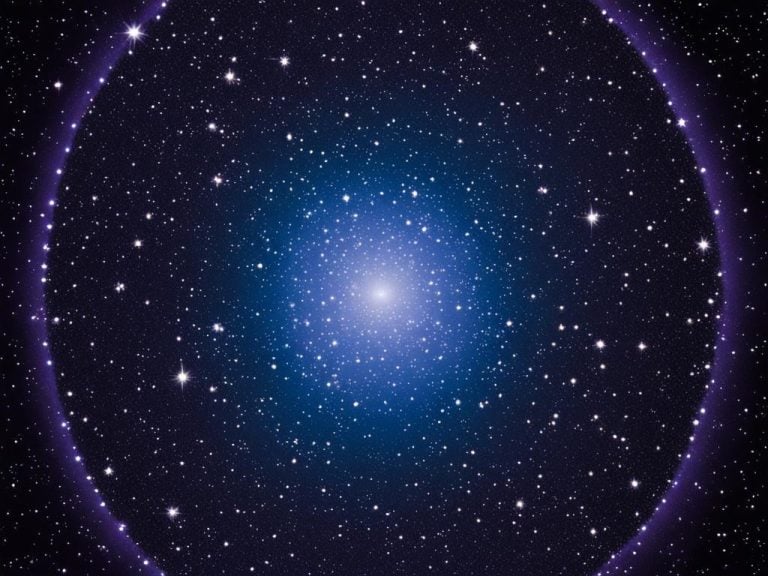Explore the Crown: Corona Borealis Constellation
Modified: August 26, 2024 Author: International Star Registry
Did you know the Corona Borealis Constellation is called the Northern Crown? It’s special in both stories and science. You can see this star pattern in the sky’s north. It’s loved for its beauty and its story.

In Greek stories, Corona Borealis is Ariadne’s crown. Dionysus gave it to her on the island of Náxos. The group of stars looks like a half-circle. This is Ariadne’s crown in the night sky.
Corona Borealis is at 16 hours right ascension and 30° north in declination. The star Alphecca is its brightest, shining with a 2.2 magnitude. This adds to its charm.
Key Takeaways:
- The Corona Borealis Constellation is also known as the Northern Crown or Crown of the North.
- In Greek mythology, it represents the crown that Dionysus gave to Ariadne.
- The constellation is visible in the northern sky and has a unique semicircular shape.
- Alphecca is the brightest star in Corona Borealis with a magnitude of 2.2.
- The constellation’s beauty and mythological significance make it a beloved subject for stargazers and astronomers alike.
The Mythological Significance of Corona Borealis
Corona Borealis comes from Greek stories filled with love, deceit, and divine workmanship. It means “Northern Crown” in Latin, for the crown worn by Ariadne, King Minos’s daughter.
In the story of the Minotaur, Ariadne helped Theseus defeat the beast by giving him a thread. This thread helped him through the maze. For her help, Theseus gave her a special crown, the Crown of Ariadne.
This crown was made by the best godly goldsmith, Hephaestus. Its design and beauty honored Ariadne’s courage and thanked Theseus. Sadly, the tale turned tragic when Theseus left Ariadne on Naxos.
On Naxos, Ariadne met Dionysus, the wine god. He was amazed by her strength and beauty and they fell in love. They got married. To celebrate, Dionysus put Ariadne’s crown in the sky as a constellation, creating Corona Borealis.
This legend shows how Greek myths combine gods, heroes, and ordinary people in grand stories. Corona Borealis lights up the night, a beautiful reminder of these ancient tales’ power.
Astronomical Observations of Corona Borealis
Corona Borealis is the northern celestial crown. It is visually captivating and great to observe with a telescope. Within it, you’ll find fascinating things like variable stars and deep-sky objects.
Variable Stars
Variable stars are an intriguing part of Corona Borealis. The R Coronae Borealis stars are especially interesting. They get dimmer over weeks but can brighten back up over months. Studying these stars helps us understand more about how stars change over time.
Deep-Sky Objects
There are many wonders in Corona Borealis. For example, the Corona Borealis Galaxy Cluster has about 400 galaxies. It gives astronomers a chance to study different galaxies and their evolution.
The Blaze Star, also in Corona Borealis, is a recurring nova. This means it suddenly gets much brighter. These events help astronomers learn more about stellar explosions.
Astronomers use powerful telescopes and special tools to study Corona Borealis.
Corona Borealis is full of variable stars and deep-sky objects. It captures the attention of both hobbyists and experts. Let’s explore the myths, history, and the astronomical treasures of this fascinating constellation.
Notable Stars in Corona Borealis
Corona Borealis, the Northern Crown, shines with stunning stars. Alphecca, Nusakan, and Gamma Coronae Borealis are its gems. Each has its own special qualities.
Alphecca, known as Gemma, is the brightest. It has a magnitude of 2.23 and shines 60 times brighter than our sun. About 75 light-years from us, it lights up the sky.
Nusakan is the second brightest at 3.68. This binary system is about 112 light-years from us. It makes the constellation even more beautiful and interesting.
Gamma Coronae Borealis shines at 3.84. It’s a binary system too, showing a beautiful dance in the sky.
These stars show the beauty of Corona Borealis. Their unique qualities and being in binary systems make them special. They’re loved by astronomers and fans of the sky.

For more stars in Corona Borealis, check the list. The northern crown is a beautiful sight at night. Look there to see the constellation. For more on Corona Borealis, visit the Wikipedia page.
Locating Corona Borealis in the Night Sky
Looking up at night, we can see the beauty of Corona Borealis. Start by finding Boötes, which is close to the Big Dipper’s handle. This handle is also known as the Plough.
Draw an imaginary line from the tip of the Plough’s handle out into the sky. You will find the bright orange star Arcturus. Arcturus shines brightly and shows you the way to Corona Borealis.
Off the left shoulder of Boötes is where Corona Borealis shines. It looks like a semi-circle, showing off the Northern Crown. It’s just a bit bigger than the space between the last two stars on the Big Dipper’s handle.
Under the night sky’s vastness, let the stars guide you. Look closely at the beautiful arc made by Alphecca and other stars in the Corona Borealis. This array is truly mesmerizing.
If you want to learn more about Corona Borealis, check out these sites:
Exploring Corona Borealis is an amazing journey through space. Stay curious, and let the stars light your way.
The Beauty of Corona Borealis
Corona Borealis captivates with its celestial wonder and unique shape. It has amazed stargazers and astronomers for ages. In various ancient stories, people saw it as a circle of elders, a bear’s den, or even an eagle’s nest. This shows how different cultures saw the night sky in creative ways.
In Celtic myths, Corona Borealis is known as Caer Arianrhod, the Castle of Arianrhod. It is seen as the home of Lady Arianrhod, a key figure in Celtic tales. The constellation’s shape, like a magical arc, adds to its charm.
Corona Borealis has an enchanting beauty and a deep history. It stands as a symbol of our lasting interest in the stars. Its wonder inspires astronomers, artists, and those who dream.
Naming a Star as a Perfect Gift
Looking for a unique gift? Think about naming a star in the Corona Borealis Constellation. International Star Registry is a trusted place for this. A star named after someone is a special gift for any event. This could be a birthday, anniversary, or special milestone.
With International Star Registry, you can pick a name for the star. Then, you get an official certificate for it. This certificate is a unique way to show love and thanks. It makes for a heartfelt and memorable present. This constellation is a favorite among celebrities. Some celebrities that have their very own stars named in Corona Borealis include Prince William, James Cameron and Markie Post.
Imagine immortalizing a special moment or honoring a loved one by giving them the gift of a star in the magnificent Corona Borealis. With International Star Registry, you have the opportunity to name a star within this celestial crown, making it a unique and timeless gesture for birthdays, Christmas, anniversaries, or any other memorable occasion.
When you buy a star from International Star Registry, you not only receive a beautifully crafted certificate with the chosen star name but also the coordinates to locate your star in the night sky. Whether it’s to commemorate a birthday, celebrate a milestone, or honor a cherished memory, naming a star in Corona Borealis adds a touch of celestial magic to any occasion.
Corona Borealis – A Springtime Delight
Corona Borealis, or the Northern Crown, shines in the spring night sky from April to May. It brings joy to those who love to look at stars. Anyone can enjoy this beautiful constellation.
This crown-shaped constellation is visible from many places on Earth. It looks like an elegant tiara in the dark sky. People find it easily due to its distinctive shape.
Corona Borealis is extra special because of its rare bursts of brightness. Every 80 years, the star T Coronae Borealis shines much brighter for a short time. This is a thrilling sight for sky enthusiasts.
Spring also brings the sight of RS Ophiuchi erupting along with the famous Perseids. In August, the comet C/2021 O1 Nishimura briefly lights up the sky. These events make spring stargazing unforgettable.
Whether you love to stargaze or just enjoy the night, Corona Borealis is magical. Its springtime appearance is something to look forward to. It turns the night sky into a wondrous display.
Want to learn more about celestial events like recurrent novae and double stars? Check out these links for more info: recurring-nova, 4-choose-a-constellation, and on-the-north-side-of-tania-borealis-with-eng-43-σ-1427-bu-1074-and-sma-75.
This image shows how beautiful Corona Borealis looks in the night sky. It captures the essence of its elegance and charm.
The Pronunciation and Abbreviation of Corona Borealis
Discussing the Corona Borealis constellation means knowing how to say it right. It’s pronounced “koh-ROH-nuh BOR-ee-AL-is.” With this guide, talking about this sky beauty becomes easy.
The abbreviation for Corona Borealis is CrB. Knowing this makes it easier to read or learn more about the constellation.
Learning the right way to say and abbreviate Corona Borealis helps you talk to others about it. This makes exploring and enjoying the night sky even more fun.
The Constellation Map of Corona Borealis
The Corona Borealis constellation map shows a beautiful star pattern. It highlights key stars like Alphecca and Nusakan. Astronomers and fans use it to enjoy the sky more.

Looking at the constellation map shows how stars in Corona Borealis connect. You can see paths and patterns it makes. This helps find Alphecca, the brightest star, and other cool spots.
- Alphecca: The Alpha star of Corona Borealis shines with a golden hue.
- Nusakan: Known as the Beta star, Nusakan adds a touch of elegance to the constellation.
- Gamma Coronae Borealis: This star illuminates the night sky, captivating observers with its brilliance.
- Cor Caroli: The famous Binary star, consisting of two stars orbiting each other harmoniously.
Stargazers use constellation maps to find stars they love. These tools are great for everyone. They make the space journey better and more personal.
Also, places like International Star Registry offer helpful astronomy resources. With their help, you can give someone a star in Corona Borealis. It’s a unique way to celebrate or show love with a star in the sky.
Conclusion
The Corona Borealis Constellation is an amazing sight in the night sky. It blends beauty, myths, and science in its stars. Many have been in awe of it for thousands of years.
According to Greek myth, the constellation is Ariadne’s crown. She was the daughter of King Minos of Crete. This story makes the constellation even more interesting.
Looking at Corona Borealis offers chances to see changing stars and deep-sky objects. These include globular clusters and galaxies. They show us how vast our universe is.
Whether you’re drawn by beauty, myth, or science, Corona Borealis is captivating. It welcomes exploration and reveals the universe’s mysteries.
FAQ
What is the Corona Borealis Constellation?
The Corona Borealis is in the northern sky. People also call it the Northern Crown or Crown of the North.
What is the mythological significance of Corona Borealis?
In Greek myths, it’s seen as a crown. They say Dionysus, a god, placed it on Ariadne’s head. This happened on the island of Náxos.
What are some astronomical observations associated with Corona Borealis?
It has unique stars and objects. For example, there are R Coronae Borealis stars. Plus, there’s the Corona Borealis Galaxy Cluster and the Blaze Star.
What are the notable stars in the Corona Borealis Constellation?
Alphecca (Gemma) is the brightest in a binary star system. Then there’s Nusakan, also in a binary system. Lastly, Gamma Coronae Borealis is in a binary star system too.
How can I locate Corona Borealis in the night sky?
Look for Boötes and the handle of the Big Dipper to find Arcturus. Then, look off Boötes’ kite-shaped core’s left shoulder to see Corona Borealis.
What makes Corona Borealis beautiful?
Its beauty comes from its semilunar shape. Plus, it’s been seen as a circle of elders, an eagle’s nest, and a bear’s den by different people throughout history.
Can I name a star in Corona Borealis as a gift?
Yes. Visit International Star Registry at starregistry.com. There, you can choose from different options to honor a loved one with a star name.
When can I observe Corona Borealis in the night sky?
You can see it from mid-April to mid-May. This makes it a favorite for springtime viewing in the north.
How do you pronounce Corona Borealis?
Say “koh-ROH-nuh BOR-ee-AL-is” to pronounce it right. The short form is CrB.
Where can I find a constellation map of Corona Borealis?
Look in astronomy guides or websites for maps. They help you learn more about the stars and their stories.
Source Links
- Constellation Corona Borealis – The Constellations on Sea and Sky – http://www.seasky.org/constellations/constellation-corona-borealis.html
- Corona Borealis | Northern Crown, Bright Stars, Celestial Crown – https://www.britannica.com/place/Corona-Borealis
- How can I see the Northern Crown? – https://www.sciencefocus.com/space/how-can-i-see-the-northern-crown
